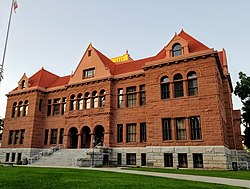|
Downtown Santa Ana
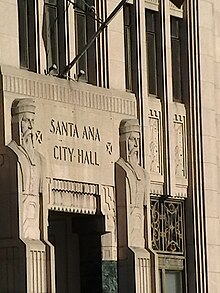 Downtown Santa Ana (DTSA), also called Downtown Orange County, is the city center of Santa Ana, the county seat of Orange County, California. It is the institutional center for the city of Santa Ana as well as Orange County, a retail and business hub. The Downtown Santa Ana Historic Districts are listed with the National Trust for Historic Preservation and consist of numerous historic buildings across the area.[2] HistoryThe City of Santa Ana was established in 1869 by William Spurgeon on 74.27 acres (300,600 m2) of land purchased from the old Spanish land grant, Rancho Santiago de Santa Ana. The County of Orange was formed in 1889 by William Spurgeon and James McFadden. Santa Ana was chosen as the county seat of government because of its larger growth as a town compared to surrounding towns such as Orange. The Old Orange County Courthouse was built in 1901. The surrounding old town buildings make up the Santa Ana Historical Downtown.[3] LocationCity studies and merchant associations generally define Downtown as the area between Ross Street on the west, Minter Street on the east, First Street on the south and Civic Center Drive on the north.[4] Neighborhood organizations define Downtown more narrowly, extending only as far east as Main Street, with the area east of Main part of the Lacy neighborhood;[5] the Santa Ana Regional Transportation Center train and bus station is located at the east end of Lacy along Santiago Avenue. Sub-districtsDowntown consists of several sub-districts: an institutional area including the Civic Center, the Artists Village, Calle Cuatro and the East End. Civic CenterThe Santa Ana Civic Center, also known as the Orange County Civic Center,[6] anchors the west side of Downtown and is home to city, county and federal buildings, including: City:
County:
Federal:
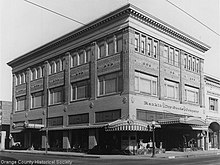 Fourth Street/Calle Cuatro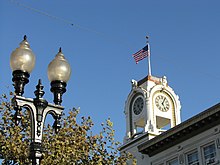 Hospitality, entertainment and retail in Santa Ana's historic Downtown are centered along historic Fourth Street, also known locally by its equivalent name in Spanish, Calle Cuatro.[7] Fourth Street stretches from the Civic Center in the west. The West End, located between Ross Street, Broadway, and West 4th Street, across from the Ronald Reagan Building, has lounge cafés, restaurants, bars, concert theaters and other retail. The middle section of Calle Cuatro (roughly from Main east to Spurgeon) has retailers  The Rankin Building, 117W Fourth Street at Sycamore, is a historic building that was usually seen as a reminder of when the Downtown Santa Ana was a shopping center, with department stores such as Rankin's, Montgomery Ward (northeast corner of Main, demolished),[8] J. C. Penney (northwest corner of Bush)[9] and Buffums. Eventually, the area lost business to the new malls at Honer Plaza and Santa Ana Fashion Square when they opened in 1958, and later on, to South Coast Plaza. The East End is a cultural hub, with restaurants and the refurbished Yost Theater. The Frida Cinema is a two-screen theater converted to an art-house theater showcasing films. In February 2015, the Fourth Street Market opened an indoor food hall along the lines of Grand Central Market in Downtown Los Angeles. Even further east, the Santa Ana Regional Transportation Center is located along Santiago Avenue in the Lacy neighborhood. Artists VillageThe Artists Village is an area composed of art galleries, studios, creative offices, design workshops, and several restaurants. It is located on Second Street at Broadway, in the center of Historic Downtown Santa Ana. The village extends from First Street to Fourth Street, Bush Street to Birch, and surrounding the Second Street Mall between Broadway and Sycamore Street.[10] It was originally proposed in the mid-1980s. In collaboration between the Santa Ana City Council, community activist Don Cribb and Cal State Fullerton’s Gallery Director Mike McGee, a plan for the Grand Central Art Center was conceived in 1994. A designated ten-square block would become the Artists Village. In the early 2000s, several developments came to the downtown including Main Street Studio Lofts, East Village, and Artists Village lofts. The Artists Village has restaurants, shops and art institutions, including Cal State Fullerton Grand Central Art Center and the Orange County Center for Contemporary Art. 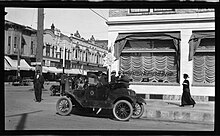 Historic districtsLocated across several of the aforementioned sub-districts, the Downtown Santa Ana Historic Districts are several historic districts listed as one entry in the National Register of Historic Places since 1984, covering 24.5-acre (9.9 ha) and characterized by a number of Art Deco buildings as well as two old movie houses (The West End and the Fox West Coast). The county's first courthouse, now a museum, is located at Civic Center and Broadway streets, as is the Howe-Waffle House and Medical Museum, now the Santa Ana Historical Preservation Society. 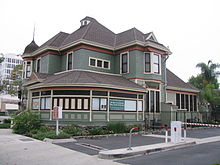 The county's first theater, Walker's Theater, was built in 1909 on Main and Second streets adjacent to the old City Hall. The Main Street Studio Lofts is located on where the county's first movie house was used to be. Old Santa Ana was designated a California Historic Landmark (No. 204) on June 20, 1935. EventsThe village has several weekly, monthly, and annual events. Some of these events include:
National historic districtThe National Register of Historic Places states that the Santa Ana Historical Downtown District is 'roughly bounded' by Civic Center Drive, 1st Street, Ross and Spurgeon. The historic district nomination form has a list of contributing properties and detailed maps of the area. The district consists of two sections with a total of 99 buildings that remain from the commercial code of Santa Ana. The buildings date from the late 1870s to the post earthquake reconstructions of 1934. The district is divided into two parts, north and south, due to a 'break' in the historic integrity.[11] Historic LandmarkHistoric Landmark at the site reads:[12]
See alsoReferences
External linksWikimedia Commons has media related to Downtown Santa Ana Historic Districts (North, Government/Institutional and South, Retail). |
||||||||||||||||||||||||||||||||||
